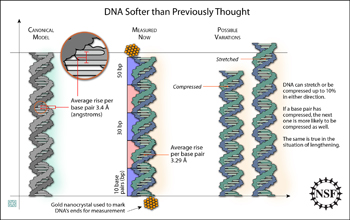News Release 08-184
More Spring in the Double Helix's Step
DNA proven softer than previously thought

DNA may compress and extend more than previously thought possible.
October 16, 2008
This material is available primarily for archival purposes. Telephone numbers or other contact information may be out of date; please see current contact information at media contacts.
The DNA's double helix--the sub-microscopic core of our life--has been the subject of intense study and scrutiny for decades.
Observations and measurements at the scale of DNA are tricky. The distance between the rungs in DNA's ladder (or base pairs), for example, was thought to be barely over 3 millionths of a millimeter, or 3.4 Å (angstroms). And this ladder has been typically assumed to be very rigid.
But now a team of Stanford scientists, supported in part by the National Science Foundation, have used a novel molecular ruler to cast doubts on this picture. Using this molecular ruler, they marked each end of a snippet of DNA with electron-dense gold nanocrystals. These markers scattered X-rays directed at the sample differently than the rest of the molecules, and allowed for a more precise calculation.
The observations led the Stanford team to discover that DNA is much softer than previously thought. Variation--both compression and stretching--was observed.
Most surprisingly, the team found that if a base pair had compressed, the base pairs in at least the next two turns of the double helix were more likely to be compressed as well.
These observations have important ramifications for biologists looking at proteins binding to DNA, such as transcription factors regulating gene expression. Because this study has shown regions of DNA affecting the behavior of neighboring regions, it could mean that proteins binding to the DNA could communicate across greater molecular distances than previously thought.
-NSF-
-
The researchers' findings are published in the Oct. 17, 2008, issue of Science magazine.
Credit and Larger Version
Media Contacts
Lily Whiteman, National Science Foundation, (703) 292-8310, email: lwhitema@nsf.gov
Michelle Brandt, Stanford University School of Medicine, (650) 723-0272, email: mbrandt@stanford.edu
Program Contacts
William J. Hahn, National Science Foundation, (703) 292-8545, email: whahn@nsf.gov
Principal Investigators
Pehr Harbury, Stanford University School of Medicine, (650) 723-6161, email: harbury@cmgm.standford.edu
The U.S. National Science Foundation propels the nation forward by advancing fundamental research in all fields of science and engineering. NSF supports research and people by providing facilities, instruments and funding to support their ingenuity and sustain the U.S. as a global leader in research and innovation. With a fiscal year 2023 budget of $9.5 billion, NSF funds reach all 50 states through grants to nearly 2,000 colleges, universities and institutions. Each year, NSF receives more than 40,000 competitive proposals and makes about 11,000 new awards. Those awards include support for cooperative research with industry, Arctic and Antarctic research and operations, and U.S. participation in international scientific efforts.
Connect with us online
NSF website: nsf.gov
NSF News: nsf.gov/news
For News Media: nsf.gov/news/newsroom
Statistics: nsf.gov/statistics/
Awards database: nsf.gov/awardsearch/
Follow us on social
Twitter: twitter.com/NSF
Facebook: facebook.com/US.NSF
Instagram: instagram.com/nsfgov

